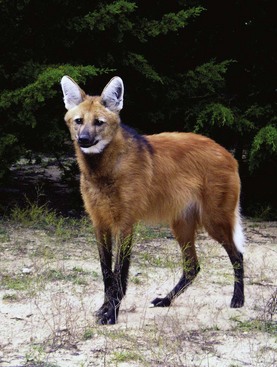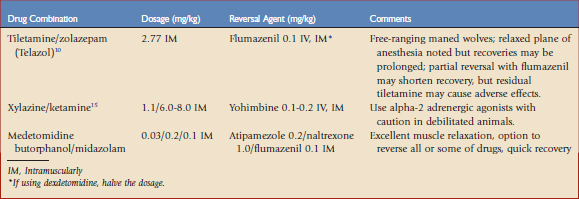Chapter 58 Medical Management of Maned Wolves (Chrysocyon brachyurus)
Biology
The maned wolf (Chrysocyon brachyurus) is the largest canid in South America, with an average weight of 25 kg.25 It is a member of the family Canidae in the order Carnivora, belongs to its own genus, and has a unique morphology. Its legs are long and stiltlike, an adaptation allowing it to maneuver easily in its native grasslands habitat, which it does with a pacing gait. The long hair coat is a rusty red color, with black or dark brown muzzle and legs (Fig. 58-1). A patch of black or dark brown hair runs along its withers and neck. This hair is often raised during encounters—thus the name “maned” wolf. The throat, inside of the large ears, and the tail tip are white. The maned wolf has a distinct odor that resembles that of a skunk. Its dental formula is I3/3, C1/1, PM4/4, M2/3 = 42.
The maned wolf is crepuscular or nocturnal and found in northeastern Brazil, northern Argentina, Paraguay, Uruguay, eastern Bolivia, and small regions of Peru.25 In its native countries, it is known by several names: lobo de crin, aguará guazú, borochi, and lobo guará. The maned wolf prefers grassland, cerrado, and scrub forest habitat. The number of maned wolves in the wild is difficult to assess because of their secretive nature. A 2005 Population Viability and Health Assessment study in Brazil estimated the wild population at 23,000, with approximately 85% found in Brazil.7 The maned wolf is classified as a Convention on International Trade in Endangered Species of Wild Fauna and Flora (CITES) Appendix II species, vulnerable by the International Union for Conservation of Nature (IUCN), endangered by the U.S. Department of the Interior (USDI), and endangered by the Brazilian government. The maned wolf’s conservation status has been most affected by habitat loss because of agricultural development, but road kills and its reputation as a predator of domestic poultry in its native countries have also negatively affected its numbers in the wild.
Husbandry
The maned wolf has been kept in captivity in the United States since the 1970s. Its secretive nature dictates special housing, especially for successful reproduction. Captive enclosures should be large (minimum, 930 m2) and contain tall grass to provide the animals with cover.15 In addition, captive maned wolves will forage natural prey items, such as insects, birds, and small mammals, which may have implications for pest control and internal parasites. Shade and hiding places should be available to allow the maned wolves to hide from public view and conspecifics.
Perimeter fencing should be a minimum of 2.3-m tall fencing, preferably with an inward overhang. The fence or a footer should be buried 46 cm in the ground to prevent wolves from digging out. Adequate shelter should be provided to protect maned wolves from the elements. Maned wolves should have access to a heated area if the temperature drops below 7° C (45° F).15
Maned wolves are often housed in male-female pairs, but same-sex sibling pairs or trios have also been successfully housed together. Attempts to introduce same-sex adults have not been successful. In addition, there are several reports of successful mixed species exhibits with maned wolves, including capybara (Hydrochoerus hydrochaeris), giant anteaters (Myrmecophaga tridactyla), and tapirs (Tapirus spp.).15
Nutrition
Maned wolf nutrition is another unique aspect of this species and an area of intense ongoing research. As an omnivore, the maned wolf ingests approximately 51% plant material and 49% animal protein, including mammals, birds, reptiles, and invertebrates, in the wild, and its diet varies seasonally.8,21,25 In Brazil, a large proportion of the plant matter ingested by the maned wolf is Solanum lycocarpum (lobeira, or “fruit of the wolf”), a relative of the tomato.
The unique diet of wild maned wolves presents challenges in captivity. Historically, captive North American maned wolves were fed carnivorous diets. Problems such as urolithiasis, loose stool, and unthriftiness arose. These issues have been mitigated by feeding a more omnivorous diet, but the captive population continues to have some of these problems. Currently, zoological institutions strive to feed their maned wolves a varied diet that includes fruits, vegetables, and whole prey items, although commercial canine kibble still constitutes a large proportion (average, 71%) of the diet.23 It is this discrepancy between the diets of zoo-housed and free-ranging maned wolves that is hypothesized to be a contributing factor to the morbidity of captive maned wolves.
A survey was conducted by the Maned Wolf Species Survival Plan in November 2006 to determine diets fed to captive North American maned wolves and correlate their health status. The survey identified approximately 26 different diets fed to maned wolves in 26 North American zoological facilities.23 The survey also asked keepers to score fecal consistency in maned wolves. It was found that in one 24-hour period, many individual animals have a variety of fecal consistencies, from very loose to firm, that may vary according to what was ingested, activity, hydration status, among other factors.
Reproduction
Maned wolves are facultatively monogamous, with pairs uniting during the breeding season. Wild maned wolves are thought to be monestrous, with a 5-day estrous cycle. Gestation lasts 63 to 67 days. In the wild, maned wolves give birth during the dry season, from June to September.25 In captivity in North America, pups are usually born from January to early March. The maned wolf litter size ranges from two to five pups, and captive male maned wolves have been observed assisting in pup rearing by regurgitating food and grooming pups.
Pregnancy may be determined by conventional methods such as radiography and ultrasound, but these usually require anesthesia. A recent study attempted to develop noninvasive pregnancy monitoring by measuring urinary relaxin.26 Although the study showed a trend that urinary relaxin increased in some pregnant females, further investigations are required to establish a relaxin antibody that is specific to the maned wolf.
Historically, synthetic progestin implants, such as melengestrol acetate (MGA), have been used in female carnivores, including maned wolves. However, this form of chemical contraception has been associated with uterine pathology in zoo canids.20 Because these side effects may cause irreversible damage to the reproductive tract, MGA implants are no longer recommended for contraception for maned wolves.
Anesthesia
For refractory animals and long and/or painful procedures, general anesthesia should be used on maned wolves. Remote darting equipment may be used to administer the drugs. However, care should be taken when darting maned wolves because there have been several reports of fractured long bones secondary to capture darts. Many anesthetic protocols used for other canid species may be extrapolated to maned wolves, and drug choice depends on the clinician’s preference. Several injectable protocols are listed in Table 58-1. Inhalant anesthesia is similar to that which is done for other canids, and isoflurane and sevoflurane are preferred. Monitoring during anesthesia and recovery is essential.
Clinical Pathology
Blood collection in maned wolves may be performed in a manner similar to techniques used for other canids. The jugular, cephalic, and saphenous veins are commonly used sites for venipuncture. Table 58-2 shows normal hematologic reference ranges for captive adult maned wolves. Serum chemistry reference ranges for captive adult maned wolves are shown in Table 58-3. Reference values for wild maned wolves in Brazil have been published recently by May-Junior and colleagues.16
TABLE 58-2 Hematologic Values for Adult Maned Wolves
| Parameter | Mean* | SD |
|---|---|---|
| White blood cell count (×103/µL) | 9.133 | 3.371 |
| Red blood cell count (×106/µL) | 5.76 | 0.88 |
| Hemoglobin (g/dL) | 14.3 | 1.8 |
| Hematocrit (%) | 42.9 | 5.6 |
| MCV (fL) | 74.8 | 7.4 |
| MCH (pg/cell) | 25.4 | 2.3 |
| MCHC (g/dL) | 33.4 | 2.1 |
| Platelet count (×103/µL) | 205 | 74 |
| Segmented neutrophils (×103/µL) | 6.475 | 2.822 |
| Neutrophilic bands (×103/µL) | 0.520 | 0.931 |
| Lymphocytes (×103/µL) | 1.751 | 0.789 |
| Monocytes (×103/µL) | 0.278 | 0.252 |
| Eosinophils (×103/µL) | 0.609 | 0.447 |
| Basophils (×103/µL) | 0.114 | 0.132 |
* Values are from Teare, ISIS.
TABLE 58-3 Serum Chemistry Values for Adult Maned Wolves
| Parameter | Mean* | SD |
|---|---|---|
| Calcium (mg/dL) | 9.4 | 0.6 |
| Phosphorus (mg/dL) | 4.3 | 0.8 |
| Sodium (mEq/liter) | 145 | 3 |
| Potassium (mEq/liter) | 4.6 | 0.4 |
| Chloride (mEq/liter) | 115 | 3 |
| Bicarbonate (mEq/liter) | 19.2 | 4.0 |
| Carbon dioxide (mEq/liter) | 18.6 | 2.6 |
| Iron (µg/dL) | 107 | 36 |
| Magnesium (mg/dL) | 3.80 | 4.06 |
| Blood urea nitrogen (mg/dL) | 26 | 8 |
| Creatinine (mg/dL) | 1.5 | 0.3 |
| Uric acid (mg/dL) | 0.3 | 0.3 |
| Total bilirubin (mg/dL) | 0.3 | 0.2 |
| Direct bilirubin (mg/dL) | 0.1 | 0.1 |
| Indirect bilirubin (mg/dL) | 0.2 | 0.2 |
| Glucose (mg/dL) | 107 | 25 |
| Cholesterol (mg/dL) | 273 | 74 |
| Triglyceride (mg/dL) | 27 | 13 |
| Creatine phosphokinase (IU/liter) | 149 | 96 |
| Lactate dehydrogenase (IU/liter) | 157 | 147 |
| Alkaline phosphatase (IU/liter) | 41 | 43 |
| Alanine aminotransferase (IU/liter) | 95 | 83 |
| Aspartate aminotransferase (IU/liter) | 44 | 31 |
| Gamma glutamyltrasferase (IU/liter) | 4 | 3 |
| Amylase (IU/liter) | 490 | 379 |
| Lipase (IU/liter) | 174 | 78 |
| Total protein (colorimetry) (g/dL) | 6.6 | 0.6 |
| Globulin (colorimetry) (g/dL) | 3.5 | 0.5 |
| Albumin (colorimetery) (g/dL) | 3.1 | 0.3 |
| Fibrinogen (mg/dL) | 97 | 118 |
| Progesterone (ng/dL) | 1.680 | 0.000 |
| Total triiodothyronine (ng/mL) | 46.9 | 65.3 |
| Total thyroxine (µg/dL) | 1.7 | 0.5 |
Stay updated, free articles. Join our Telegram channel

Full access? Get Clinical Tree




